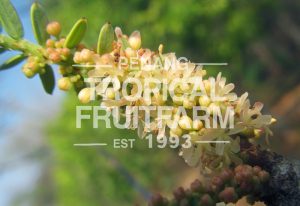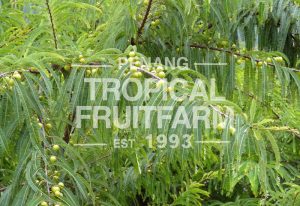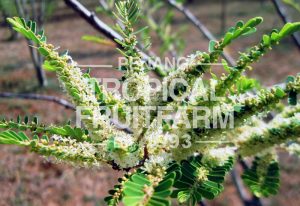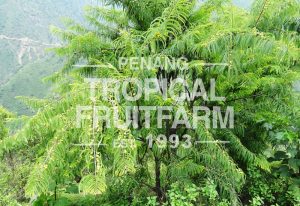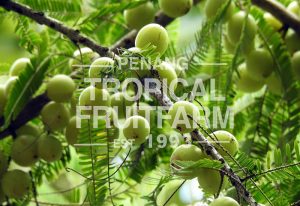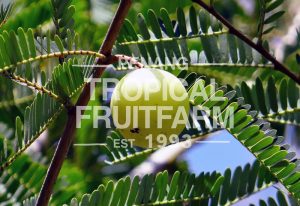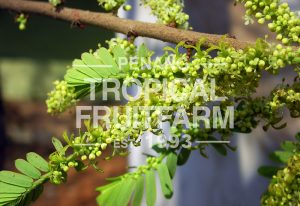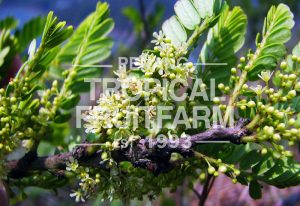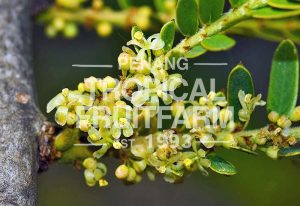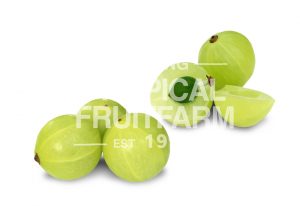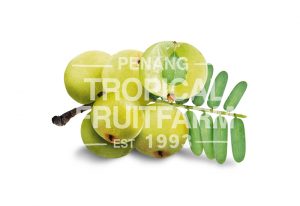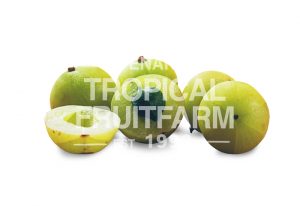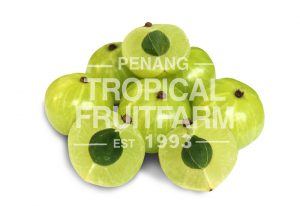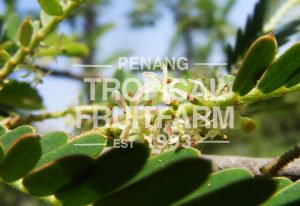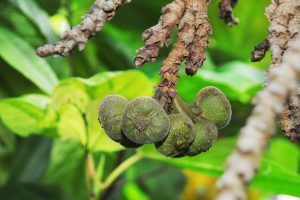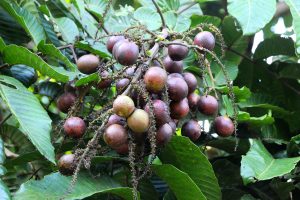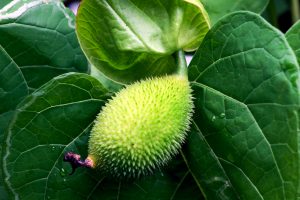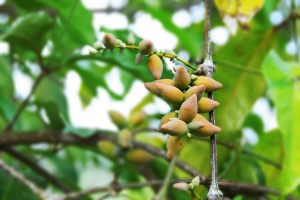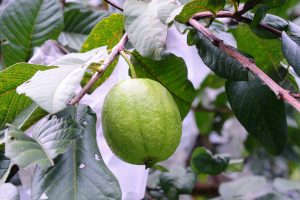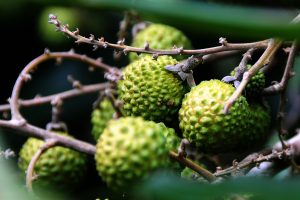| Origin | The Indian Gooseberry tree is native to tropical southeastern Asia, particularly in central and southern India, Pakistan, Bangladesh, Sri Lanka, Malaysia, southern China and the Mascarene Islands. |
| Description | The Indian Gooseberry fruit is a whitish-green, translucent fruit with six stripes that looks like a gooseberry, the size of an over-large marble. Very high in Vitamin C. |
| Growth Habitat | The Indian Gooseberry is subtropical rather than strictly tropical. The tree seems to grow equally well under both dry and humid conditions. |
| Foliage | The leaves are simple, miniature, oblong and closely set along branchlets, light green, resembling pinnate leaves. |
| Flowers | Small, inconspicuous, greenish-yellow flowers are borne in compact clusters in the axils of the lower leaves. Usually, male flowers occur at the lower end of a growing branchlet, with the female flowers above them, but occasionally trees are either male or female. |
| Fruits | The fruit is roundish, indented at the base, and smooth. The 6 to 8 pale lines, give it the appearance of being divided into segments. Light-green at first, the fruit becomes whitish or a dull, greenish-yellow, or rarely brick-red as it matures. It is hard even though the skin is thin and translucent. The fruit is very crisp and juicy but astringent, extremely acidic and sometimes bitter. Tightly embedded in the center of the flesh is a slightly hexagonal stone containing 6 small seeds. |
| Harvest | The fruiting season is exceptionally long since the ripe fruits can keep on the tree for several months without spoiling. Since it is a firm, long-lasting fruit, it lends itself to mass harvesting, bulk packing and long-distance transportation to processing centers. |
| Soil | For maximum productivity, the tree requires deep soil ranging from sandy loam to clay, light or heavy, slightly acidic to slightly alkaline. |
| Pruning | Prune back hard each year. If the tree begins producing inferior fruit, cut the tree back to about 4 feet in the spring and treat cut surfaces with coal tar. |
| Fertilization | Fertilizer may be applied for the plant's first decade, if desired. Use about 28g of nitrogen for every year of the plant's age and apply half of this fertilizer after the fruit sets (or in the spring, if the plant isn't producing fruit yet) and the rest about four months later. |
| Propagation | The Indian Gooseberry tree is often propagated by seeds taken from sun-dried, overripe fruits to facilitate removal of the stone, or cut in half right around the stone. The extracted seeds are given the float test and 100% of those that sink will germinate. Cuttings, inarching and budding are also successful. |
| Nutritional Properties | The Indian Gooseberry fruit is an extremely rich source of ascorbic acid (vitamin C), 100 g of juice containing 600–1300 mg, sometimes even more. The tannin in the fruit prevents or retards the oxidation of the vitamin, so that the fruits can be preserved in salt solution or as dry powder while still maintaining their antiscorbutic value. The fruit contains a potent polyphenol called gallic acid that aids in antioxidant activity. It also has calcium, iron, phosphorus, carotene, thiamine, riboflavin, and niacin. Has anti-inflammatory, antiviral, antibacterial, antimicrobial, astringent, carminative, hemostatic, aphrodisiac, refrigerant, vermifuge, diuretic, and laxative properties. |
| Health Benefits | Stimulates appetite, cures indigestion, gastritis, hyperacidity, constipation and heartburn. Good for hemorrhoids, and colitis. Balances stomach acids, improves food absorption, and regulates the functioning of nervous system. Highly effective in curing all sorts of urinary and prostate gland disorders. Maintains proper liver function and increases hemoglobin. It fights against cell degeneration and cancers. Helps in reducing blood sugar level, cholestrol and strengthens heart muscles. Enhances production of red blood cells. Strengthens teeth, hair and nails. Helps heal eye disorders like conjunctivitis and glaucoma even dim vision. Helps relief symptoms of rheumatoid arthritis and osteoporosis. The root and bark is helpful in the treatment of minor hemorrhages. The juice is very effective in curing all sorts of vomiting, nausea, car-sickness, travel. Sickness and sea-sickness. Stimulates hair follicles for faster growing hair and preventing of premature graying. Helps induce sleep if its juice is taken before retiring to bed at night. Enhances fertility, flushes out toxins, and nourishes the skin.. |
| Commercial Uses | The leaves are employed for dyeing matting, bamboo, silk, wickerwork and wool into brown colours. Matting can be dyed dark colours with a decoction of the bark. The fruits are used to prepare a black ink and a hair dye. . They are usually made into jam, jelly or syrup, or prepared in cooked food, or as sweetmeat and pickle. Immature fruits, bark and leaves are used for tanning in India and Thailand, often in combination with other tanning materials. Leaves and fruits are used for animal fodder; can also be applied as green manure. Although the wood may warp and split, it is used for poles, furniture and agricultural implements. Very durable when submerged in water. Produces charcoal of good quality. . A standardized extract of the Melaka plant is traded in the United States as a component of anti-ageing, sunscreen and general-purpose skin care products. |
| Food Suggestion | The Indian Gooseberry fruit Chutney Ingredients : • 300 gms Melaka fruit • 250 gms Green Corainder (Cilantro) • 2 small Ginger • 100 gms Green Chillies • 1 tsp Salt Instructions: 1. First of all take coriander and clean it by washing. 2. Now, chop the Melaka fruit into various small pieces and remove the seed. 3. Thereafter, you will chop green chilies and ginger. 4. Then put all the ingredients in a mixer and make it into a fine paste. Your mouth-watering Melaka fruit chutney is ready to be served! |

